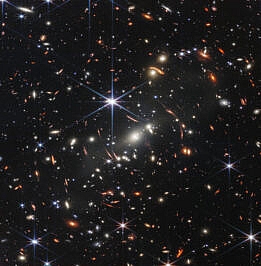NASA unveiled the first color images of faraway galaxies from the James Webb Telescope on Tuesday.
Summary
NASA unveiled the first color images of faraway galaxies from the James Webb Space Telescope on Tuesday.
- President Joe Biden released the first image Monday afternoon at the White House, a high-resolution, full-color photo of a galaxy cluster from the early days of the universe.
- Tuesday’s batch included photographs of the births of stars, black holes in the Southern Ring Nebula, and the Carina Nebula.
- The James Webb Telescope is “the largest and most powerful orbital observatory ever launched.” The $9 billion telescope launched on Christmas Day 2021 and lies in solar orbit one million miles from earth.
- The Webb Telescope images are “the farthest humanity has ever seen in both time and distance, closer to the dawn of time and the edge of the universe.”
![]()
- The New York Times explained how NASA picked the first five images to release. A small team used a mixture of “on-the-fly science, public communication, and brand management” to select the best images to “blow everyone’s mind” and show that all the spending was worth it.
- CNN quoted NASA Administrator Bill Nelson, who said The James Webb Space Telescope “represents the best of NASA” and “maintains our ability to propel us forward for science, risk-taking, and for inspiration. We don’t want to ever stop exploring the heavens.”
- NPR detailed the five areas depicted in the five images: “the exoplanet WASP-96 b; the Southern Ring Nebula; the Carina Nebula; Stephan’s Quintet (five galaxies in the constellation Pegasus); and the galaxy cluster SMACS 0723.”
![]()
- The Wall Street Journal called the Webb Telescope release the “dawning” of “a new era of astronomy.” NASA Administrator Bill Nelson said Tuesday, “It’s progress like this that drives us forward and gives us inspiration. Our rockets run on fuel. But inspiration is the fuel that drives NASA and indeed, drives humanity.”
- The Washington Examiner reported the James Webb Space Telescope found “the signature of water” and cloud evidence on gas giant exoplanet WASP 96-b, located 1,150 light-years away.
- Breitbart explained how the $10 billion observatory works. It “uses infrared cameras to gaze into the distant universe in unprecedented clarity.”
© Dominic Moore, 2022






